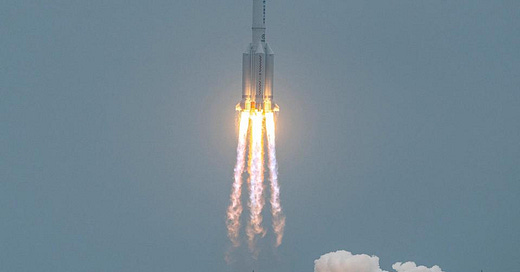There's a Chinese rocket falling uncontrollably back down to Earth
This headline sounds scary, and it would be if you lived in the ocean.
The Chinese National Space Administration recently launched the first module for their brand-new space station. Like we talked about last week, the ISS’s reign is coming to an end. This, in addition to China being largely left out of ISS operations, led the Chinese government to start building their own. The module that they sent up did a wonderful job getting there. The 22-ton first stage booster brought it out of the atmosphere and the second stage rocket did the rest. [1] Woohoo! Only one issue: as of May 5th, 2021, that first stage booster is in an uncontrolled decaying orbit around Earth.
We’re not yet sure what caused the booster to lose control, but we do know enough to say it can’t be stopped and we don’t know where it will land. A decaying orbit means that the rocket is not high enough nor moving fast enough to stay in space—eventually, Earth’s gravity will pull it back down. Uncontrollable in this case means that it isn’t able to use boosters to slow itself down and land in a safe location. Usually, these stage-one rockets fall back to Earth, but they can control and guide themselves to a designated landing site.
Do we know where it is? Yep. Then why can’t we tell where it’s going? Well at the time of writing (5/5 5:28 pm EST), Space-Track.org tracks the rocket to about here: [2]
Unfortunately, this doesn’t mean it will land there. It’s moving laterally (northeast) at about 18,000 mph. [1] So, if you’re reading this at 8:28 pm EST, it’s already circled the globe twice.
Even though we can see where it is and know what its orbit looks like, because of its speed, we don’t really know how or when it will re-enter the atmosphere. The good news is when that happens, a few hours before it actually lands, we’ll have a much better idea of its trajectory, and where exactly debris will fall. To better visualize its current orbit, I searched a lot for a good picture. I couldn’t find one. So, I took the available orbital elements (characteristics of an object’s orbit) and plugged them into a Matlab script. Don’t say I never did anything for you.
The red circle is where it is currently, in the South Pacific. All things considered, the rocket is projected to re-enter the atmosphere between May 8th and 10th. [1] When this happens, it will slow down significantly, and a whole lot of it will burn up. The parts that don’t, however, are what present an issue. This debris could eventually make landfall traveling at hundreds of miles per hour and could be as big as multiple feet.
That said, don’t freak out. I know I haven’t provided a particularly nerve-settling argument, so I’ll finish with the good news. It won’t hit you. I can confidently say that because of, well, statistics. You personally take up a surface area of about 2 square feet. The Earth is roughly 5.5x10^15 square feet, a vast majority of which is water. My [disclaimer] very rough estimate of the odds of anything hitting you is 1 in 2,750,000,000,000,000. That’s 15 zeros. You’re fine. I’d be inclined to agree with Jonathan McDowell, an astrophysicist from Harvard, in placing my money on it landing in the Pacific Ocean. [1] If you’re still concerned about it, keep track of it on the news and get yourself a nice, big umbrella.
Thank you for reading this edition of It’s Not Rocket Science; I’ll see you next week. Don’t forget to subscribe for more content like this!
Check out last week’s newsletter here.
Disclaimer: The orbital trajectory presented in this article was found using multiple assumptions about orbital elements. It does not represent the exact orbit of the object.
For more details…
[1] https://www.cnn.com/2021/05/04/politics/chinese-rocket-earth-scn/index.html
[2] https://www.maps.google.com/
[3] https://www.cnn.com/2021/04/29/world/iss-future-china-space-station-russia-us-intl-scn/index.html







Phew! Excellent article.
Thank you for this. I will sleep better tonight! Sort of...